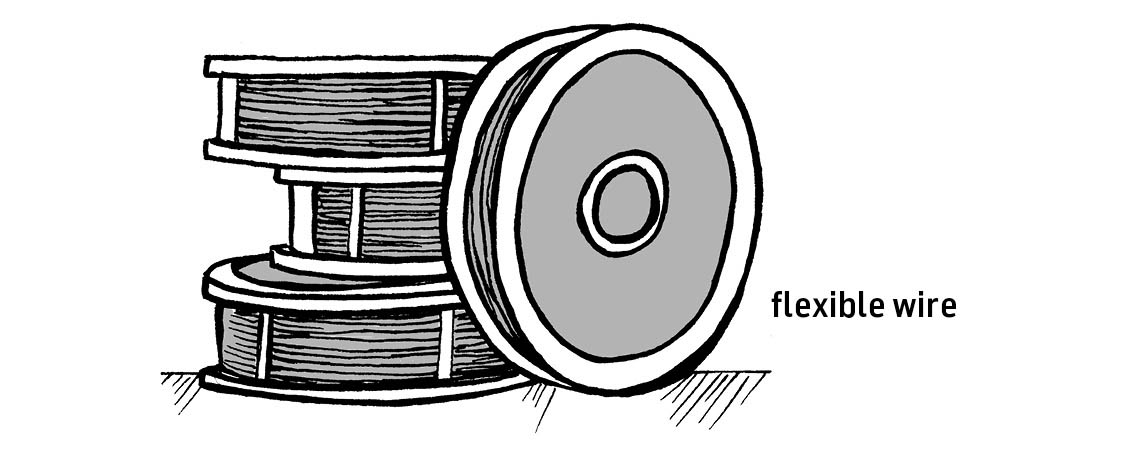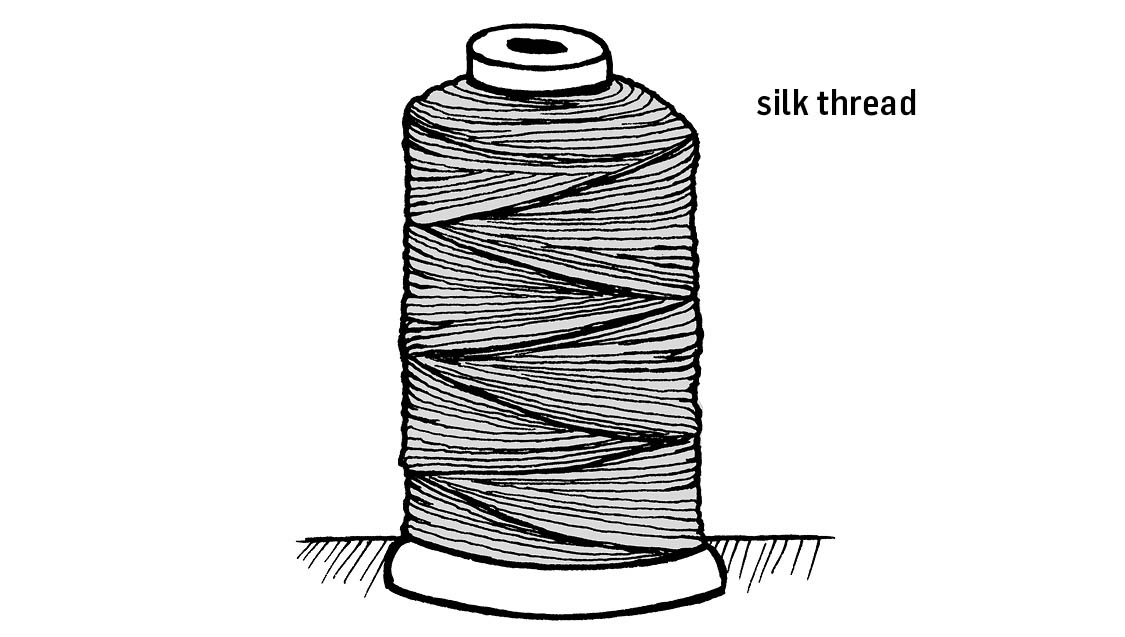
Stringing materials are the foundation of all strung beaded jewelry. Stringing materials are made from a wide range of materials from silk to steel. Popular choices include flexible beading wire, leather cord, silk thread, elastic, nylon, and rubber. Most stringing materials are available in a variety of diameters to accommodate a range of bead hole sizes. All of this variety allows for a great deal of creativity in designing bracelets and necklaces.
Flexible beading wire is a strong, nylon-coated stainless steel beading wire. It is one of the most popular stringing materials used today. Clasps are easily and securely attached to this stringing material with crimp beads. The size and type of crimp beads used depends on the diameter of the flexible beading wire.
Two popular brands of flexible beading wire are SoftFlex and Beadalon. Both brands offer the best quality choices, in a variety of diameters, flexibilities, and colors. In addition to the standard silver, gold, and base metal colors, flexible beading wire comes in other colors, including black, white, and a range of seasonal fashion colors.
For most stringing projects, it is best to select the thickest wire that will fit comfortably through the beads being used. Different diameters of flexible beading wire are recommended for different sizes and weights of beads.
Selecting a flexible beading wire with a higher number of strands of steel reduces the possibility of the wire kinking after the beads are strung. If your project won’t relax and hang nicely after being strung, try restringing it on a narrower diameter flexible beading wire or on nonstretch nylon cord.
Another variable to consider when selecting flexible beading wire is the number of strands the wire is made with. Beadalon produces a good-quality wire made with only seven strands of stainless steel. This is the least flexible wire they make. Both SoftFlex and Beadalon produce wires made with 19 or 21 strands of stainless steel that are stronger and more flexible. The best wires that SoftFlex and Beadalon produce are made with 49 strands of stainless steel wire, making them by far the strongest and most flexible.

Even though flexible beading wire is very popular for stringing beads, some styles of jewelry or certain beads are better strung on natural stringing materials. The natural qualities of these stringing materials add an organic feel to jewelry strung on them. Popular cords made from natural materials include leather, cotton, linen, and silk.
Leather is a common option. The tanned hide is dyed and formed into round cord ranging in dimension from .05 millimeter to 5 millimeters. The most common sizes of leather cording are 1.5 millimeters and 2 millimeters and are used to string beads with 2 millimeter to 3 millimeter holes.
The finest-quality leather cording is made in Greece from cowhide. Lower-grade, less-supple leather cording comes from India and China.
Coil crimps are glued and crimped to the ends of the leather cording to attach a clasp.
Suede comes from the underside of cow or deer hide that has been stripped of the hard skin layer to leave a napped surface. Suede is dyed and then cut into a flat cord. Because suede does not have the tough outer layer, it is softer and less durable than leather cording. Suede is generally used with large beads that have large holes.
Fold-over crimps are used to attach a clasp to suede cord.
Waxed cotton is a thick, tightly woven cotton cord that is lightly waxed for durability. Waxed cotton comes in several diameters and is good for stringing beads with holes that match the diameter of the cord.
Both foil crimps and fold-over crimps can be used to attach a clasp to waxed cotton cord.
Waxed linen is a thin, tightly spun, linen cord that has a waxy surface that is applied for durability. Waxed linen comes in many colors and is popular for micro macramé and for stringing beads with smaller holes.
Bead tips can be added to the ends of waxed linen when adding a clasp.
Hemp is a strong, environmentally friendly fiber. Hemp is primarily used for macramé but can be used for stringing larger, organic beads. Hemp is manufactured in several thicknesses and is dyed in a complete range of colors.
Both foil crimps and fold-over crimps can be used to attach a clasp to hemp.
Silk is most commonly used for knotting between beads but can also be used to string small, lightweight beads. It comes in a variety of sizes or diameters appropriate for most sizes of beads and bead holes.
One of the most popular types of silk cord is carded silk. This twisted silk comes wrapped on a card with the beading needle already attached. Carded silk comes in sizes #0 (0.30 mm) to #16 (1.05 mm). Silk is also available on spools and is commonly used for longer knotting projects. Spooled silk comes in sizes 00 (0.012 mm) to FFF (0.419 mm).
Bead tips can be added to the ends of silk cord when adding a clasp.

For some projects, a man-made stringing material is the best choice. Cord, elastic, and ribbon made from man-made materials are very popular with those who prefer vegan options, for designs that require stretch, or for any application where a natural material is not suitable. Jewelry that will never be taken off or that is worn in the water frequently is often best strung on a man-made material for durability.
Genya is a round, synthetic leather stringing material. It is perfect for those who prefer a vegan stringing material or for jewelry that will be exposed to moisture on a regular basis. The most common diameters are 1 millimeter and 2 millimeters, which will fit beads with holes larger than 1 millimeter.
Coil crimps are used to attach a clasp to Genya.
Elastic cording is ideal for making stretchy jewelry projects. A clear, round type of stretch cord is used for stringing bracelets and anklets. It comes in three thicknesses and does not require the use of a beading needle. Clear round stretch cord can easily be finished with a square knot and a drop of strong glue.
Multistrand, flat stretch cord can be used for stringing bracelets and anklets, but requires a big eye or twisted wire needle to string beads with. Flat stretch cord can also be finished with a square knot and a drop of super glue or clear nail polish.
Cotton-covered elastic cord used in sewing clothing is useful for stringing heavier beads. The cord has an opaque elastic core that is covered with a tightly woven cotton cover. This type of elastic comes in a number of colors.
Ribbon comes in all sorts of materials and weaves including velvet, organza, grosgrain, and satin. This flat stringing material is particularly good for making simple flat chokers and bracelets.
Special ribbon crimps are used to attach a clasp to a piece of ribbon jewelry. For thin ribbon, bead tips or fold-over crimps can be glued and crimped when adding a clasp.
Satin cord is a round, synthetic silk cording that comes in a range of beautiful colors. It comes in 1 millimeter and 2 millimeter diameters and is used for simple stringing projects. One- millimeter satin cord is sometimes called “mouse tail,” and 2 millimeter satin cord is sometimes called “rat tail.”
Coil crimps or fold-over crimps are used to attach a clasp to satin cord.

Nylon cording comes in several different varieties. The first is a bonded, no-stretch nylon thread that is popular for both stringing and knotting projects. The second is a 3-ply, twisted, multifilament nylon cording that is great for stringing, crochet, kumihimo, and micro macramé. This product comes in three weights: fine, medium, and heavy.
Bead tips are used to finish nylon cording when adding a clasp.
Clear nylon cord can be used for bead stringing, for creating illusion necklaces, and for off-loom weaving. This cord comes in several diameters to work with a range of bead hole sizes. Clear nylon cord can be knotted or crimped.
Crimp beads are used to attach a clasp to clear nylon cord.
Rubber is a waterproof stringing material that comes as both hollow and solid round cording. Common diameters of rubber cording are 1 millimeter, 2 millimeters, and 3 millimeters.
Coil crimps, fold-over crimps, or glue-on ends can be used to attach a clasp to rubber cording.